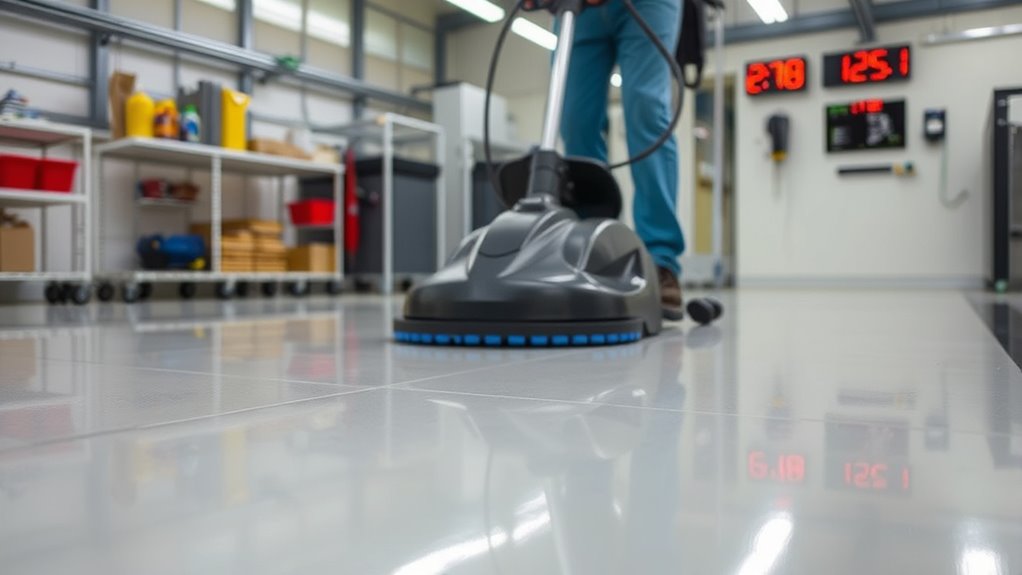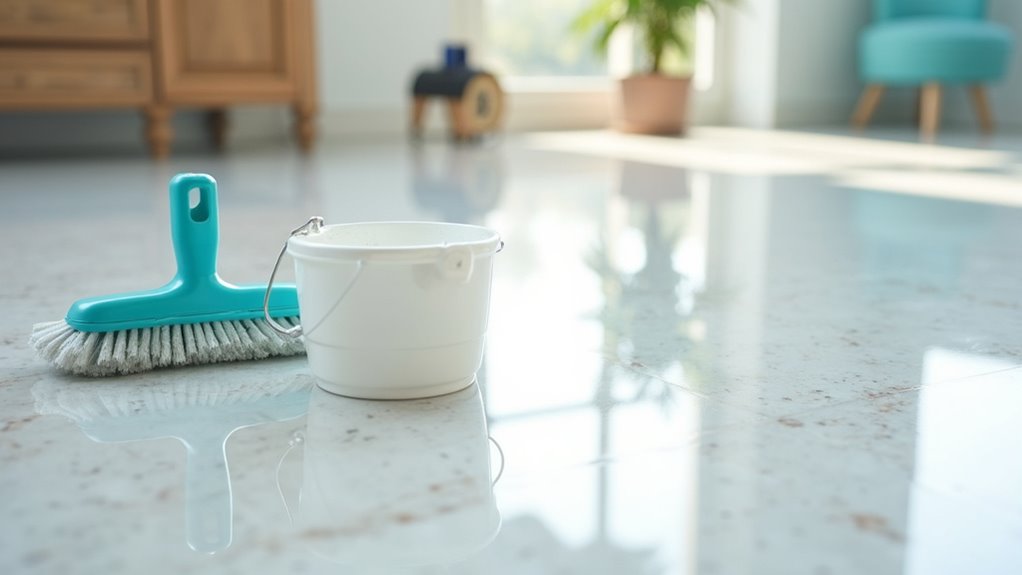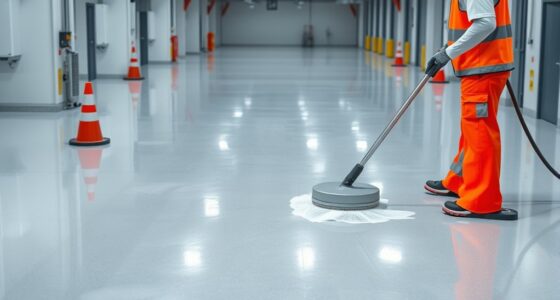To keep your epoxy floors looking their best, sweep or vacuum daily to remove loose dirt and debris, then lightly scrub with a gentle pad and water or a pH-neutral cleaner for a streak-free shine. Weekly, perform a deeper scrub to lift stains and stubborn dirt, checking for signs of wear. Monthly, inspect for damage, consider applying a sealant, and perform thorough cleaning to maintain their durability. Continuing with these routines will help you maximize your epoxy floors’ lifespan and appearance.
Key Takeaways
- Daily cleaning involves sweeping or vacuuming to remove loose dirt and light damp mopping with a pH-neutral cleaner.
- Weekly routines should include deeper scrubbing with appropriate pads and solutions to lift stains and prevent buildup.
- Monthly maintenance includes inspecting for damage, performing thorough cleaning, and applying protective sealants or polish if needed.
- Use suitable scrubber pads and tools, replacing worn equipment regularly to ensure effective cleaning without damaging the epoxy.
- Consistently follow scheduled routines to maintain gloss, prevent surface degradation, and extend the epoxy floor’s lifespan.

Maintaining your epoxy floors with a scrubber is essential to keep them looking polished and to extend their lifespan. A proper cleaning routine not only preserves their glossy finish but also prevents dirt, debris, and chemical buildup from causing damage over time. To achieve this, you need to establish effective maintenance routines and adhere to consistent cleaning schedules tailored to the level of foot traffic and usage. Daily, weekly, and monthly care are all vital components of a comprehensive maintenance plan that ensures your epoxy floors stay in optimal condition.
On a daily basis, your primary focus should be on removing loose dirt, dust, and surface grime. Use a gentle scrubber or pad that’s suited for epoxy surfaces to avoid scratching or dulling the finish. Regular sweeping or vacuuming helps prevent debris from settling into the surface, which can cause scratches when walked on or cleaned with more aggressive tools. After sweeping, lightly dampen the scrubber with water or a pH-neutral cleaner designed for epoxy floors. This prevents streaks and residue buildup, maintaining the floor’s shine. Keep in mind that daily cleaning routines should be quick but thorough, targeting high-traffic areas to prevent dirt accumulation that can degrade the surface over time. Incorporating proper cleaning techniques ensures the longevity of your epoxy surface and prevents premature wear.
Weekly cleaning routines require a more detailed approach. Once a week, perform a deeper scrub using a scrubber with a soft or medium pad, paired with a suitable cleaning solution. This helps lift stains, grease, or stubborn dirt that accumulates over days. It’s important to follow manufacturer instructions for cleaning agents to avoid damaging the epoxy surface. During this weekly routine, inspect the floor for any signs of wear or damage, such as chips or cracks, and address these issues promptly to prevent further deterioration. Regularly changing and maintaining your scrubber pads ensures effective cleaning and prevents dirt from being redistributed across the surface.
Monthly maintenance should focus on thorough inspections and possibly deep cleaning, especially in commercial or high-traffic environments. Use a more aggressive scrubber if necessary, but always with care to avoid stripping the epoxy’s protective layer. At this interval, you might also consider applying a quality epoxy floor polish or sealant to enhance shine and add an extra layer of protection. This helps in maintaining the epoxy’s integrity and aesthetic appeal longer. Additionally, check your scrubber equipment for wear and tear, replacing worn brushes or pads to ensure optimal performance during every cleaning session.
Adhering to proper maintenance routines and cleaning schedules not only keeps your epoxy floors looking their best but also significantly extends their lifespan. Consistency is key — neglecting routine cleaning can lead to costly repairs and a dull, damaged surface. With careful, scheduled care, your epoxy floors will continue to impress and serve their purpose effectively for years to come.
Frequently Asked Questions
Can I Use Steam Cleaning on Epoxy Floors?
Yes, you can use steam cleaning on epoxy floors, but you need to verify chemical compatibility first. Steam cleaning effectively removes dirt and grime without harsh chemicals. make certain your epoxy finish is rated for high heat and moisture exposure, as excessive steam can cause damage or delamination. Always test a small area first, and use a low-pressure steam setting to prevent any potential harm to your epoxy surface.
Are There Specific Scrubber Machines Recommended for Epoxy Surfaces?
Using the right scrubber machines for epoxy floors is like choosing the perfect paintbrush. You’ll want to opt for gentle, non-abrasive options. Automated scrubbers with soft brushes are ideal, providing consistent cleaning without damaging the surface. Manual scrubbers with microfiber pads work well for spot cleaning. Avoid heavy-duty machines with harsh brushes, as they can scratch or dull your epoxy’s finish. Always select equipment designed for delicate surfaces.
How Often Should I Replace Scrubber Pads for Epoxy Floors?
You should replace scrubber pads when their longevity diminishes, typically every 100 to 150 hours of use, or when they show signs of excessive wear. Establish a consistent replacement schedule based on your cleaning frequency and pad condition to maintain peak cleaning performance. Regularly inspect pads for fraying or loss of abrasiveness, and replace them promptly to prevent damage to your epoxy floors and guarantee efficient cleaning.
What Chemicals Should I Avoid When Cleaning Epoxy Floors?
You should avoid harsh cleaning agents like ammonia, bleach, and acidic or alkaline chemicals, as they can cause adverse chemical reactions with epoxy floors. These reactions may lead to surface damage, discoloration, or deterioration of the coating. Instead, opt for pH-neutral cleaners specifically designed for epoxy surfaces. Always read labels carefully to prevent unintended chemical interactions, ensuring your floor stays protected and maintains its glossy finish.
Is There a Difference Between Wet and Dry Scrubbing for Epoxy Floors?
Ever wondered if wet or dry scrubbing makes a difference for your epoxy floors? It’s essential because dry scrubbing with dust mops removes loose dust and debris, preventing scratches. Wet scrubbing, on the other hand, uses chemical cleaners and water to tackle stubborn dirt. Choosing wisely depends on your floor’s condition. Neglecting this step could lead to damage, so always consider the type of cleaning needed to protect your epoxy surface.
Conclusion
Keep your epoxy floors shining like a mirror by sticking to your scrubber care routine. Daily, weekly, and monthly upkeep act as a gentle breeze that keeps dirt and grime at bay, ensuring your floors stay pristine and resilient. Think of your cleaning schedule as a trusted dance partner, guiding your floors through their routines with grace and ease. With consistent care, your epoxy floors will continue to gleam like a star, lighting up your space for years to come.









